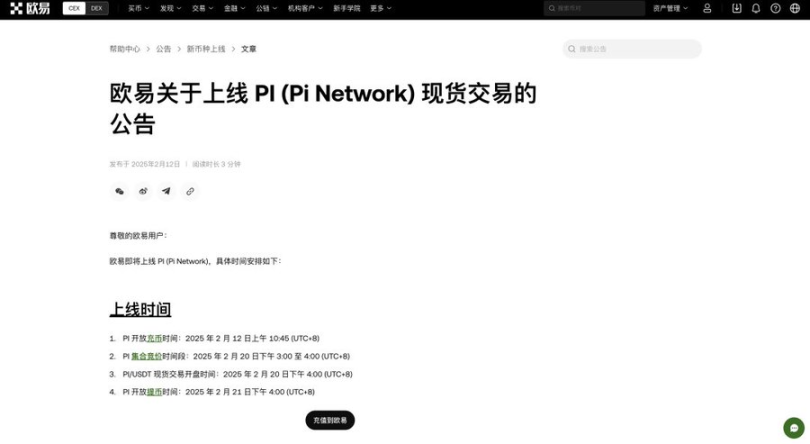True innovation is not simple imitation, but finding ways to achieve sustainable growth within a compliance framework.
Written by: Liu Honglin
On February 12, 2025, the OKX exchange released an "exciting" announcement: OKX's announcement regarding the launch of Pi (Pi Network) spot trading.

According to the announcement, Pi Network, a highly controversial and large community crypto project in China, is finally set to officially launch its mainnet after 6 years. It is believed that once this announcement is made, a large number of domestic users will cheer with joy. Finally, they can stop generating power with love!
However, Pi Network is rarely mentioned in the mainstream Web3 circle.
Regarding the mainnet launch, the well-known Web3 media outlet Planet Daily published an article titled "Countdown to the 'King of Pyramid Schemes' Pi Mainnet: Are the 60 Million Brainwashed People About to 'Realize Their Dreams'?" The article points out: After six years of sharpening the sword, is it still a sickle? The launch day of Pi will become the "ultimate test of IQ tax." Previously, the relevant information that could be found in mainstream media was mostly linked to regulatory news and keywords like "pyramid scheme."
Additionally, the attitude of regulatory authorities in our country towards Pi Network and related projects is increasingly severe. For example, in April 2022, the Nantong police issued a notice warning the public about the risks of Pi mining; similarly, in 2022, Ping An Sanming published an article titled "Organizing Lectures, Gatherings… The 'π Coin' Scam in Sanming Has Already Trapped Many People," to alert the public; subsequently, local police and related regulatory agency accounts, such as Wuxi Online Police, Dehong Police, and Linyi Banking Association, issued warning notices/articles.
In fact, lawyer Mankun found that although official agencies are more focused on warning about fraud issues, most mentions of Pi Network criticize it as a "Ponzi scheme" or "pyramid scheme." Why is there such a statement?
The "Crazy" Explosive Growth of Pi
From 2019 to the present, in just 6 years, Pi Network has accumulated over 60 million users through its "free mining + viral promotion" model, achieving astonishing growth speed. Among these, community viral promotion is the core growth method—users can earn Pi coins by clicking to check in daily, and by inviting new users, they can increase their mining speed.

Since there is no need to invest funds throughout the process, and the community promotion model is simple, low-threshold, and easy to form community consensus, combined with the team's long-term creation of "high future value" market expectations, this model has rapidly spread globally.
However, this growth model has also almost crossed all the red lines of pyramid schemes.
In a previous article by lawyer Mankun titled "Guide to Preventing Criminal Risks in Web3 Entrepreneurship (Part 1): Identifying and Preventing Pyramid Scheme Risks," the essence and characteristics of pyramid schemes were outlined. The article pointed out that as long as the business activities simultaneously involve paying an entry fee, developing downlines, and tiered compensation, it constitutes pyramid scheme behavior.
The viral model of Pi Network happens to resemble this.
Firstly, the revenue model relies on attracting new users. The mining mechanism of Pi essentially does not depend on the user's computing power but rather on whether the user remains active and invites new users. This means that the user's earnings do not come from real productive activities but depend on whether they can bring in more new users. This model can easily evolve into a typical "head-hunting" model rather than a genuine decentralized economic system.
Secondly, the market value is controlled by the team. Although Pi does not require users to directly pay fiat or crypto assets, its "threshold for obtaining tokens" is binding personal information and completing KYC (identity verification), and the issuance process of KYC qualifications is controlled by the team. In some markets, "black market KYC services" have even emerged, indirectly forming an "entry cost." Meanwhile, the team has long restricted the circulation of Pi, preventing users from freely buying and selling, and the market value of the tokens entirely depends on when the team opens trading permissions. This artificially created sense of scarcity makes it more like a "Ponzi scheme" rather than a true Web3 project.
Additionally, there is a hidden design of tiered compensation. On the surface, Pi users do not directly receive earnings from downline payments, but inviting new users can increase their mining speed, which is essentially a form of implicit "tiered earnings." Users at different levels enjoy different rights to token appreciation, and early joiners hold an advantageous position in the community, similar to the "pyramid structure" in pyramid schemes. This reliance on community viral growth and encouragement of tiered growth makes Pi more like a viral system with financial Ponzi attributes rather than a true decentralized financial innovation.
Although Pi is labeled as a pyramid scheme, it cannot be denied that Pi's development demonstrates an extreme capacity for viral expansion. And this is a capability that is scarce in Web3 projects.
However, do all viral growth strategies really touch upon pyramid scheme issues? Can other Web3 projects learn from the viral model?
Viral Growth ≠ Pyramid Scheme
The traditional internet has long since played out various viral growth strategies. But the core factor that truly determines whether viral promotion is legal is the way users contribute value.
Looking across the Web3 industry, many projects have attempted similar promotional strategies, such as task incentives in GameFi, social viral growth in SocialFi, and even some projects are marketing platforms specifically providing viral growth strategies. However, to avoid being classified as a pyramid scheme by regulators, Web3 projects need to be built on real user contributions and a transparent token economic system, rather than solely relying on attracting new users to create value.
User Growth = Actual Contribution
If Pi's problem lies in "the viral rewards being directly linked to the number of new users," then a compliant viral model must ensure that user rewards come from actual behavioral contributions rather than merely recruiting people, avoiding the formation of an up-downline relationship or tiered compensation for new user recruitment.
For example, Galxe adopts "on-chain behavior incentives," requiring users to complete on-chain interactions (such as governance voting, NFT holding) before they can receive rewards.
The core logic of these models is: viral promotion is merely a means, while value contribution is the core. As long as user rewards are linked to actual contributions rather than solely relying on developing downlines, the risk of pyramid schemes can be avoided.
Transparent Token Circulation Mechanism
Another key issue with Pi is that the project party has long controlled token circulation, preventing users from freely buying and selling, which makes the market completely subject to team decisions, easily forming a Ponzi structure, and also making it easy for regulatory agencies to classify it as market manipulation or even illegal fundraising.
Therefore, a compliant viral growth model needs to be based on a more transparent and secure token ownership mechanism, including actual use cases, decentralization (i.e., not fully controlled by the team), and compliance registration to accept regulation.
In simple terms, a truly compliant viral growth model must conform to the closed loop of value contribution → community viral growth → transparent market circulation, rather than the logic of attracting new users for profit → market thirst → speculative exit of funds.
Community Viral Growth + DAO Governance, Replacing Tiered Compensation
"The inviter enjoys higher mining rewards," this marketing tactic can essentially be considered an invisible tiered reward, which easily forms a pyramid structure, and this is also a clear characteristic of why Pi is considered a pyramid scheme. Therefore, compliant viral promotion needs to avoid this structure.
Currently, some Web3 projects are using DAO governance models to guide the value of community viral growth back to ecological contributions. In this way, the overall viral model is no longer a one-way tiered incentive but a decentralized contribution mechanism, ensuring that the growth brought by viral strategies is sustainable.
Summary by Lawyer Mankun
Pi Network once again proves to the Web3 industry that strong community viral growth is one of the strongest driving forces for growth in the crypto market. However, its model also exposes the dilemmas of Web3 growth—when the value growth of tokens is decoupled from real economic contributions, and projects rely on users to attract new users to create bubble value, this model is often easily classified by regulatory agencies as a "pyramid scheme" or "Ponzi scheme."
Currently, the global regulatory environment is becoming increasingly strict, and the growth logic of Web3 has long since departed from the previous "barbaric development," moving towards "compliant viral growth." If one merely replicates the Pi model without making any adjustments, what awaits may not be user dividends, but rather regulatory crackdowns.
Because true innovation is not simple imitation, but finding ways to achieve sustainable growth within a compliance framework.
免责声明:本文章仅代表作者个人观点,不代表本平台的立场和观点。本文章仅供信息分享,不构成对任何人的任何投资建议。用户与作者之间的任何争议,与本平台无关。如网页中刊载的文章或图片涉及侵权,请提供相关的权利证明和身份证明发送邮件到support@aicoin.com,本平台相关工作人员将会进行核查。




